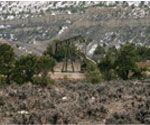|
Print Page | ||||||||||||||||||||||||||||
| BMPs | |||||||||||||||||||||||||||||
What are Best Management Practices (BMPs)? Best management practices (BMPs) are innovative, dynamic, and improved environmental protection practices applied to oil and natural gas drilling and production to help ensure that energy development is conducted in an environmentally responsible manner. BMPs protect wildlife and landscapes as we work to develop vitally needed domestic energy sources. If you are new to Best Management Practices (BMPs), visit our General Information page. Best Management Practices and the Bureau of Land Management The way of life Americans take for granted depends upon stable, abundant, and affordable sources of energy. Energy is vital to our quality of life and to our economic and national security. The US Bureau of Land Management (BLM) manages 261 million acres of public land and manages another 700 million acres of subsurface minerals. Our management meets the needs of today without compromising our ability to meet the needs of future generations. The BLM continues to improve the way it manages oil and gas development on the public lands. BLM issued a Best Management Practice (BMP) policy on June 22, 2004. The policy instructs field offices to incorporate appropriate BMPs into Applications for Permit to Drill and associated on- and off-lease rights-of-way approvals. By reducing the area of disturbance, adjusting the location of facilities, and using numerous other techniques to minimize environmental effects, BLM is significantly reducing impacts associated with new energy development to wildlife habitat, scenic quality, water quality, recreation opportunities, and other resources. Numerous oil and gas operators have developed and used BMPs. BMPs are not "one size fits all." The actual practices and mitigation measures best for a particular site are evaluated through the National Enviornmental Policy Act process and vary to accommodate unique, site-specific conditions and local resource conditions. Oil and natural gas production is a long-term, but not a permanent, use of public land. BMPs represent a commitment to the idea that smart planning and responsible follow-through reduce impacts to resources, both now and in the future. BMPs are a significant tool in the BLM's pursuit of enhancing quality of life for all citizens through balanced stewardship of America's public lands and resources. LinksWestern Governors’ Association Coal Bed Methane BMPs Handbook
For additional links, please visit the BMP Technical Information Page. Contacts If you have questions, comments, or BMPs you would like to share, please contact:
|
|||||||||||||||||||||||||||||








